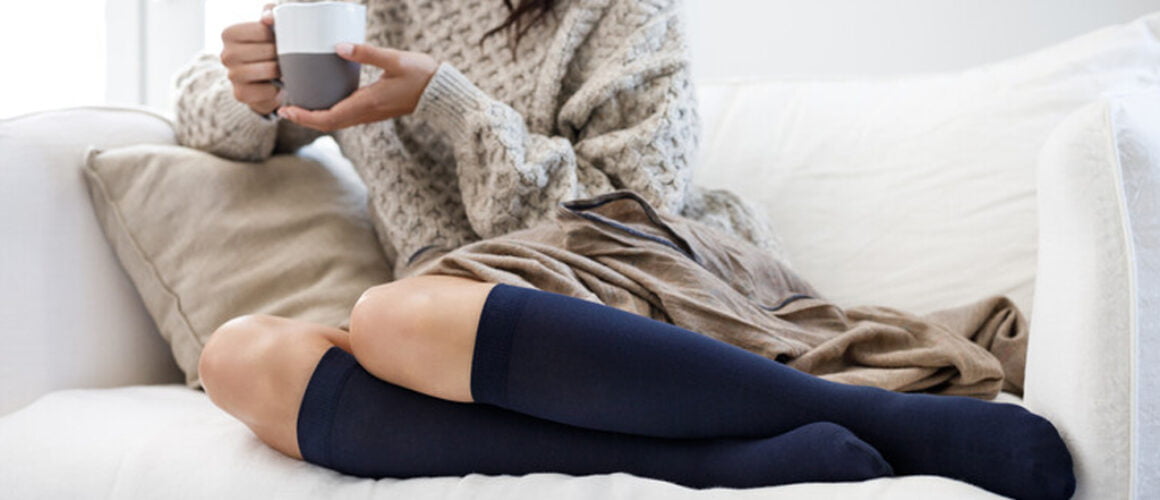Health Benefits of Compression Stockings

Introduction:
We have compiled, from separate sources, “Health Benefits Of Compression Stockings”. The reference links are at the bottom of the article.
What Are Compression Stockings For?
Compression stockings are specially designed to apply pressure to your lower legs, helping to maintain blood flow and reduce discomfort and swelling.
They may be prescribed by your GP if you have a condition that causes poor blood flow in your legs, such as:
- varicose veins (swollen and enlarged veins)
- lymphoedema (when your body’s tissues swell up)
- Wearing compression stockings
- Compression stockings come in a variety of sizes, lengths and colours. They’re also available with different strengths of compression.
Your legs will be measured to see what size stockings you need, and your GP or nurse will check they fit properly.
You may need to wear them on both legs, or just on 1.
You should wear your compression stockings during the day and take them off before going to bed. Put them on again first thing in the morning.
You should be given at least 2 stockings, or 2 pairs if you’re wearing them on both legs.
This means you can wear 1 stocking (or pair) while the other is being washed and dried.
Handwash your stockings at about 40C (comfortable hand temperature) and dry them away from direct heat.
Your GP will monitor your progress. You should have your legs measured again and your stockings replaced every 3 to 6 months.
How They Help
Dr. Botek notes that there are plenty of studies and evidence that compression socks work, particularly with regard to venous problems of the legs. “Nearly 90% of leg disorders originate within the veins,” she notes.
One example is venous insufficiency. “That’s the failure of the valves of the veins to function,” Dr. Botek explains. “Your blood would be retained in the legs and you’d have diminished returns to the heart.”
By gently squeezing the legs, compression socks increase the pressure in the tissues beneath the skin. “This reduces excess leakage of fluid from the capillaries,” Dr. Botek adds, “and it increases the absorption of this tissue fluid by the capillaries and lymphatic vessels.”
The result: reduced swelling and swelling prevention. Additionally, Dr. Botek says, “It also reduces the ability of superficial veins to expand in order to fill with blood, which prevents that blood from flowing backward and causing congestion.”
If blood pools in the veins of the legs, she says, that can cause a variety of problems including skin changes, damage to vein walls and valves, inflammation of the vein (also called phlebitis thrombophlebitis), varicose veins and even blood clots.
Besides venous insufficiency, Dr. Botek also says that another common reason for wearing compression socks is to aid in blood flow when you’re sitting for long periods of time, like a long flight.
With less movement and weaker circulation, there’s more pooling and retention of blood in the legs which can raise chances of clots. While the threat of clots isn’t that high if you’re healthy, you’ve probably noticed discomfort or swelling still taking place on long fights. Compression socks help keep that circulation going and reduce those symptoms.
The Types Of Compression Socks
You’ll generally find two types of compression socks: graduated and anti-embolism stockings. As always, be sure to check with your healthcare provider with any questions you have.
Graduated compression socks are the more common types you’ll find and what most people use. While available in a range of compression tightness, these socks are all tightest around the ankle, getting looser the higher up the leg they go. Compression socks generally come in two lengths — knee-high and thigh-high — but full compression tights are growing more common with athletes.
Anti-embolism stockings are more specific in purpose. They’re designed to help maintain circulation, thus preventing blood clots, for bed-bound patients, particularly those confined to bed after surgery.
Do Athletes Benefit From Compression Socks?
It’s not uncommon to see athletes in various sportswear different iterations of compression socks or even compression sleeves. According to Dr. Botek, while there’s not a lot of evidence to support “a mechanism of action” for athletes wearing compression socks, there has been some evidence that it can help recovery.
“There was an Australian study that looked at runners that found that compression socks could possibly have a positive impact on subsequent running performance,” she said. In other words, if you wear compression socks for a run, you might have a better run the next time out.
According to Dr. Botek, there have been theories about the effects they have for a runner’s circulation — increasing oxygen delivery to muscles, improving blood circulation, speeding the removal of lactic acid — but, she says we don’t really know yet if that’s the case.
“It can be about personal preference, too,” she adds. “People might wear them because they feel good and everyone wants that little competitive advantage.”
But she does add that there’s one advantage for athletes to wear compression socks and that’s protection. “The materials that compression socks are made from are usually thicker than the average sock so they’re protecting the skin and keeping the legs warm and dry.
Conclusion:
Thank you for reading this article and check back frequently for other similar articles.
To know more about Compression Stockings, Visit our website: https://www.factorydirectmedical.com/product-category/compression-stockings/
Article compiled by www.factorydirectmedical.com
Article Reference Links:
- https://www.nhs.uk/common-health-questions/accidents-first-aid-and-treatments/how-long-should-i-wear-compression-stockings-to-improve-my-circulation/#:~:text=Compression%20stockings%20are%20specially%20designed,veins%20(swollen%20and%20enlarged%20veins)
- https://health.clevelandclinic.org/what-you-should-know-about-compression-socks/

